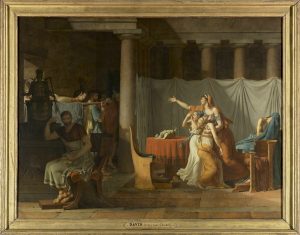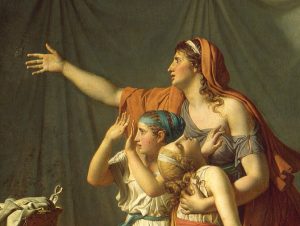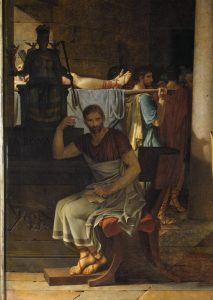
In his painting Lictors Bringing to Brutus the Bodies of His Sons (1789), Jacques-Louis David (1748-1825) portrays a moment from Roman history that had never been illustrated before. Even though the partially mythical story of Brutus has been the subject of art before David, this scene showing the aftermath of the execution is a product of the painter’s imagination – not found in historical sources such as Plutarch or Livy. The story of Brutus captures a great moral dilemma. After exiling King Tarquin, the event that marked the founding of the Roman Republic, Brutus discovers that his sons are implicated in a plot to restore the monarchy. Having sworn an oath to never allow Rome to be ruled by Kings again, Brutus condemned his own sons to death.
Until relatively recently, the recognition the painting received was largely due to its association with the French Revolution. It depicts Brutus, the founder of the Roman Republic, as a man of a will strong enough to put his own sons to death in order to protect the republic. The fact that the painting was first displayed in 1789, the year the French Revolution began, seemed to show David’s commitment to the republican cause. However, this interpretation of Brutus was later judged to be inappropriate. The association with the French Revolution cannot be a part of the original intention of the painting since David could have not predicted the later events of 1789. Thus, the intentions are likely to be significantly less propagandistic than initially thought.
It is more plausible to think of David’s intention as producing another painting of the exampla virtutis tradition after the great success of the Oath of the Horatii (1784), a paradigmatic example of the tradition. Yet, after we abandon the propagandistic reading, the question of the painting’s moral and political value becomes more pressing. It becomes harder to claim that the work has value over and above the value of run-of-the-mill exampla virtutis paintings that justifies its distinctive place in the history of Western art.
The exempla virtutis tradition was popular among neoclassical painters who turned to ancient sources and picked out examples of virtuous behavior to show the art viewing public. Hence, there is a significant element of moral education intended in these paintings, including David’s Brutus. However, Brutus provides a more nuanced kind of moral education than the typical exempla virtutis painting. It exemplifies one of the primary virtues of art: Brutus “reveals us to ourselves”.1
The painting exhibits many of the main characteristics of the neoclassical movement. The background is understated; the columns are covered with a drape that draws focus away from the background, emphasizing the figures in the foreground. The figures in the painting are arranged in ranks: the lictors and the dead bodies of Brutus’ sons are positioned furthest from the viewer, while Brutus himself, sitting in the dark, is closest, with his wife and daughters placed in between. The number of figures in the final painting is significantly less than the studies, giving the final painting a more austere feel. This feeling of austerity is augmented by subdued colors and delicate brushwork. Even though Brutus’ wife is reaching toward her dead sons, Tiberus and Titus, one does not get a sense for movement and all the figures appear frozen.

Two features, however, break away from the neoclassical tradition: composition and light. The composition of Brutus has been the subject to significant criticism beginning with the initial exhibition, despite its enthusiastic overall reception.2 The main criticism was that the painting lacked compositional unity. The principle figure of the painting is separated from the other main group, his wife and daughters, by light and placement so that critics suggested that the painting could actually be cut into separate paintings.3 Similarly, Brutus, the main figure whose virtue is supposed to be an example to the audience, is placed in the dark. This contrasts starkly with the Horatii where the virtuous figures are placed in the foreground depicted clearly in good lighting. Hence lighting constitutes another break from the neoclassical tradition. Nevertheless, these two features contribute to the main virtue of the painting and to its cognitive value.
The cognitive value of art is one of the major points of contention in the field of philosophical aesthetics. Proponents of the skeptical side argue that the truths that art convey are trivial. Even the greatest works, such as Austen’s Pride and Prejudice, contain only trivial truths, like the proposition “Stubborn pride and ignorant prejudice keep attractive people apart”.4 The skeptics say that this proposition is knowable without Austen’s help and, in any case, it is not that surprising or impressive of a truth. Or think about great Greek tragedies. In this great body of literature the kernel of truth to be found is something like “His hybris destroys the tragic hero”.5 If this is the principle truth that we can discern in this great body of literature, then art might really be cognitively trivial.
What might be the truth that we find in David’s Brutus? Perhaps the painting is teaching us that “We should be ready to make great sacrifices for our country”. This message would certainly resonate with the French public that was on the brink of a revolution. Many people found themselves in situations that required great sacrifice for the sake of what they believed to be the good of France. This can perhaps explain the enthusiastic reception of the work. However, did people really need David’s painting in order to know this? The answer seems to be no. Many people who never saw David’s Brutus are aware of this proposition.
If we focus on the group on the right, the wife and the daughters, another possibility arises. It is possible that the painting is teaching us the dangers of blind political fanaticism. In his fanatical commitment to the Republic, according to this line of reasoning, Brutus has forgotten what was really important and turned against his own family. It is in fact the mother who is worthy of our admiration. Unlike Brutus, who is sitting in the shadows, looking like a mad man, she has not lost her humanity. Moreover, despite her extreme grief, she is able to support her children, holding one of her daughters who is passing out at the sight of her beheaded brothers.6 Hence, the painting may also be conveying a proposition contrary to the aforementioned proposition: “Some sacrifices should not be made even if it is in the interest of the country”.

I claim that the painting does not decide between the two propositions and both readings are equally plausible. Therefore, the moral dilemma is unresolved. This, however, is not a failure. If Brutus was a piece of moral or political philosophy, then we could see that as a failure. The end goal of philosophical writing is to reach a truth. Even if the conclusion cannot be proved with certainty, we at least demand that the credence we have in it is increased after reading the philosophical work. Art, on the other hand, does not necessarily make one proposition more plausible than the other. Instead, it can have a subjective kind of value. Even though, it might not teach us what we should believe or value, it can teach us what we in fact believe or value. In this sense, art reveals us to ourselves.
David’s Brutus is an exceptional example of art that reveals to the viewer something about themselves. Because of the compositional disunity, our eyes wonder between Brutus and his wife. At each instance we try to figure out whom we sympathize with. Is it Brutus with his iron will, who despite his severe decision is keeping his composure, or is it his wife who is there for her family in the aftermath of Brutus’ chilling deed? Through this act of contemplation we learn what we value, where our alliances lie. This, I believe, is the moral and political value of David’s Brutus. Even though the propagandistic reading lost its plausibility, the painting remains exceptionally political. The resonance it had with the public at the dawn of the Revolution is perfectly understandable. At a time when people had to decide where their alliances lay, David’s painting helped them do just that.
Sources and further reading
Danto, Arthur (1964), “The Artworld,” Journal of Philosophy 61: 571-584.
Nanteuil, Luc de (1990), Jacques-Louis David. New York: H.N. Abrams.
Puttfarken, Thomas (1981), “David’s Brutus and Theories of Pictorial Unity in France,” Art History 4: 291-304.
Stolnitz, Jerome (1992), “On the Cognitive Triviality of Art,” British Journal of Aesthetics 32: 191-200.
Footnotes
1. Danto, p. 571
2. Puttfarken, pp. 292-293
3. Ibid, p. 291
4. Stolnitz, p. 193
5. Ibid, p. 194
6. David seems to have thought of this element later in the painting process, as it is not in the studies.
© Mert Ateşsal
Read more Story Behind the Picture entries.
